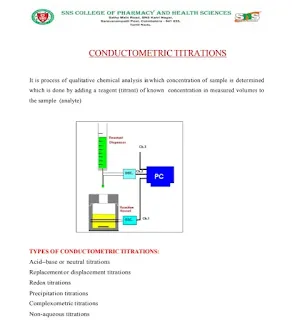Conductometric Titrations - PDF & PPT Downloads
Download these resources on Conductometric Titrations, including a PDF document and a PPT presentation. Learn about the principles, instrumentation, techniques, and applications of conductometric titrations in analytical chemistry.
Keywords: Conductometric Titrations, Conductivity, Titration, Analytical Chemistry, PDF Download, PPT Presentation, Instrumentation, Applications, Equivalence Point, Conductivity Cell, Acid-Base Titrations, Precipitation Titrations, Complexometric Titrations.
Mastering Conductometric Titrations: A Comprehensive Guide
Conductometric titrations are a valuable analytical technique used to determine the concentration of a substance by monitoring the changes in electrical conductivity during a titration. This method is particularly useful when the endpoint of a traditional titration is difficult to observe visually. This guide will provide you with a detailed understanding of the principles, instrumentation, and applications of conductometric titrations.
Principles of Conductometric Titrations:
Conductometric titrations rely on the principle that the electrical conductivity of a solution is directly proportional to the concentration of ions present. As a titrant is added to the analyte solution, the conductivity changes due to the reaction between the titrant and the analyte. These changes in conductivity are monitored to determine the equivalence point, which corresponds to the point where the reaction is complete.
Instrumentation:
The basic instrumentation for conductometric titrations consists of:
- Conductivity Cell: A conductivity cell contains two electrodes immersed in the solution. The conductivity cell measures the conductance of the solution between the electrodes.
- Conductivity Meter: A conductivity meter measures the conductance of the solution and displays the results.
- Titrator: A titrator is used to dispense the titrant into the analyte solution in a controlled manner.
- Stirrer: A stirrer is used to ensure that the solution is well-mixed during the titration.
Techniques for Performing Conductometric Titrations:
The following steps are typically involved in performing a conductometric titration:
- Prepare the analyte solution: Dissolve a known amount of the analyte in a suitable solvent.
- Set up the titration apparatus: Place the conductivity cell in the analyte solution and connect it to the conductivity meter.
- Add the titrant: Add the titrant to the analyte solution in small increments, while stirring the solution.
- Measure the conductivity: After each addition of titrant, measure the conductivity of the solution.
- Plot the data: Plot the conductivity values against the volume of titrant added.
- Determine the equivalence point: The equivalence point is determined by finding the point on the graph where the conductivity changes sharply.
Types of Conductometric Titrations:
Conductometric titrations can be used for various types of titrations, including:
- Acid-Base Titrations: Determining the concentration of acids and bases.
- Precipitation Titrations: Determining the concentration of ions that form precipitates.
- Complexometric Titrations: Determining the concentration of metal ions that form complexes with EDTA.
Applications of Conductometric Titrations:
Conductometric titrations have a wide range of applications in analytical chemistry, including:
- Water Quality Analysis: Determining the concentration of ions in water samples.
- Pharmaceutical Analysis: Determining the concentration of drug substances.
- Food Analysis: Determining the concentration of ions in food samples.
- Environmental Monitoring: Monitoring the levels of pollutants in the environment.
Advantages of Conductometric Titrations:
- Can be used for colored solutions where visual indicators are not effective.
- Can be used for dilute solutions.
- Can be automated for continuous monitoring.
By understanding the principles, instrumentation, and applications of conductometric titrations, you can effectively use this technique for a wide range of analytical purposes. Download the PDF and PPT resources to further enhance your knowledge and skills in this area.
Info!
If you are the copyright owner of this document and want to report it, please visit the copyright infringement notice page to submit a report.

